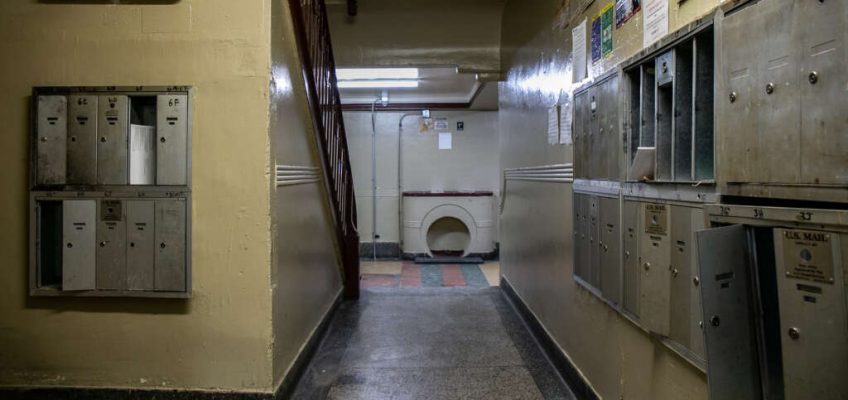“It is antisocial to systematically underfund the management and upkeep of affordable housing. Buildings deteriorate, and health and safety hazards spread, all to the detriment of residents.”
(Adi Talwar for City Limits)
We all know that New York City is in a housing crisis, and needs more quality, affordable, stable housing to meet the needs of residents.
But we are also experiencing an accelerating crisis in the portion of our housing stock that is dedicated to the social goals of long-term affordability and tenant stability. This is because housing policies and programs have focused on keeping rents low without adequately providing for the ongoing operation and management of housing.
Let’s call this “antisocial housing.”
Why? It is antisocial to systematically underfund the management and upkeep of affordable housing. Buildings deteriorate, and health and safety hazards spread, all to the detriment of residents.
It is antisocial to tell residents that rents will remain permanently affordable at low levels, without a realistic plan for how the building will continue to operate. When we deny the true costs of operating and maintaining a building, deferred maintenance and capital upgrades are pushed off onto a future generation of residents (or taxpayers). When the future arrives and buildings cannot afford major investments, routine maintenance, or even emergency repairs, residents’ stability and quality of life suffers.
It is antisocial to implement policies that increase the cost of operating housing while preventing building revenues from keeping up. If rents collected can’t cover increasing salaries, maintenance, repairs, utility bills, facade maintenance, insurance, loan repayment, regulatory compliance, marketing, resident services, and other necessities, no owner can maintain an adequate residential environment.
Some have suggested that nonprofit ownership of housing could solve the problem. But nonprofit organizations already own and manage much of our regulated affordable housing stock, while rising expenses, diminished rent collections, and numerous other factors are bringing mounting financial and physical distress to rent-stabilized and affordable housing.
Mission-based housing nonprofits often have sophisticated professional staffing and capacity, but when costs exceed revenues, they are no more able to pay the bills than any other landlord. Advocates have begun raising alarms and calling for financial support. Residents and neighborhoods will suffer the worst if nonprofits fail, or if owners default or abandon housing as they did a half-century ago.
Some others have suggested that government ownership is the solution. But New York City’s public housing provides perhaps the starkest illustration of the consequences of underfunding. Public housing was built without capital reserves to cover long-term costs, then subsidized to support people at the lowest incomes, then starved of the subsidies necessary to support these costs. It is not “social” for people to live in the appalling conditions that too many public housing residents in New York City currently endure.
Still others have suggested that freezing rents is a solution. But freezing rents amidst rising costs is like scratching a mosquito bite—a short-sighted response that will make problems worse.
The distress plaguing much of the city’s Mitchell-Lama rental housing reveals this. These buildings were intended to be financially self-sustaining, but rents were effectively frozen by a process that made increases untimely and difficult, while costs grew substantially. The promise of flat housing expenses was an illusion, and mounting capital needs and financial distress eventually required rent increases, often so large as to be dislocating to residents.
Faced with a choice between saving their finances or those of residents, many buildings exited the program—diminishing the stock of affordable housing—while others that remained languish in deteriorating conditions that increasingly resemble those of public housing.
Failing to plan adequately for expenses shortchanges the well-being of residents and the future habitability of housing, regardless of who owns the building.
Fixing our antisocial housing problem is a matter of math, not politics or ideology. Both tenants and building owners must be able to consistently pay their bills. This requires housing policies that combat rising operating expenses, alleviate administrative burdens, and confront the incremental costs of new regulations.
It requires realistic rent-setting and financial planning for buildings, adequately funding property management, and making effective use of all available government funds for affordable housing.
It requires processes that ensure residents pay their rent, a relentless defense of the federal programs that provide a lifeline for low-income renters—Section 8, SNAP, Medicaid—and bolstering rental assistance.
At this stage, it will also require broad-based financial assistance to put a potentially large number of buildings back on a sound financial footing. The longer this takes, and the more public policy limits revenues without alleviating costs, the greater the damage will be to our affordable housing supply.
Too many low-income New Yorkers can’t pay the rent needed to keep a roof over their heads. Waiting for the roof to cave in is not a solution.
Howard Slatkin and Sarah Watson are executive director and deputy director of Citizens Housing and Planning Council, a nonprofit policy organization.
The post Opinion: NYC’s ‘Antisocial’ Housing Problem appeared first on City Limits.


Leave a Reply